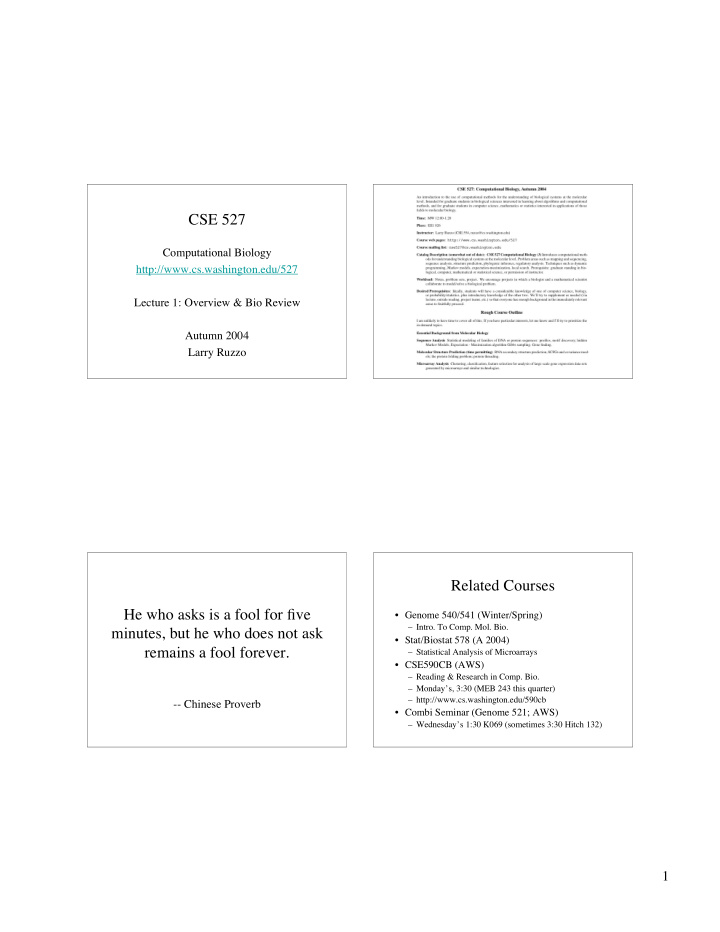



CSE 527 Computational Biology http://www.cs.washington.edu/527 Lecture 1: Overview & Bio Review Autumn 2004 Larry Ruzzo Related Courses He who asks is a fool for five • Genome 540/541 (Winter/Spring) – Intro. To Comp. Mol. Bio. minutes, but he who does not ask • Stat/Biostat 578 (A 2004) remains a fool forever. – Statistical Analysis of Microarrays • CSE590CB (AWS) – Reading & Research in Comp. Bio. – Monday’s, 3:30 (MEB 243 this quarter) – http://www.cs.washington.edu/590cb -- Chinese Proverb • Combi Seminar (Genome 521; AWS) – Wednesday’s 1:30 K069 (sometimes 3:30 Hitch 132) 1
Homework #1 • Find & read a good primer on “bio for cs” (or vice versa, as appropriate) e.g., see ones listed on 590cb page • Email me a few sentences saying – What you read (give me a link or citation) – Critique it for your meeting your needs – Who would it have been good for, if not you Source: http://www.intel.com/research/silicon/mooreslaw.htm Growth of GenBank (Nucleotides) What’s all the fuss? 100,000,000,000 • The human genome is “finished”… 1,000,000,000 • Even if it were, that’s only the beginning • Explosive growth in biological data is revolutionizing biology & medicine 10,000,000 “All pre-genomic lab techniques are obsolete” (and computation and mathematics are 100,000 crucial to post-genomic analysis) 1980 1985 1990 1995 2000 2005 Source: http://www.ncbi.nlm.nih.gov/Genbank/genbankstats.html 2
The Genome • The hereditary info present in every cell A VERY Quick Intro To • DNA molecule -- a long sequence of Molecular Biology nucleotides (A, C, T, G) • Human genome -- about 3 x 10 9 nucleotides • The genome project -- extract & interpret genomic information, apply to genetics of disease, better understand evolution, … The Double Helix DNA • Discovered 1869 • Role as carrier of genetic information - much later • The Double Helix - Watson & Crick 1953 • Complementarity – A ←→ T C ←→ G Los Alamos Science 3
Genetics - the study of heredity Cells • Chemicals inside a sac - a fatty layer called • A gene -- classically, an abstract heritable the plasma membrane attribute existing in variant forms ( alleles ) • Prokaryotes (e.g., bacteria) - little • Genotype vs phenotype recognizable substructure • Mendel • Eukaryotes (all multicellular organisms, – Each individual two copies of each gene and many single celled ones, like yeast) - – Each parent contributes one (randomly) genetic material in nucleus, other organelles for other specialized functions – Independent assortment Chromosomes Mitosis/Meiosis • 1 pair of DNA molecules (+ protein • Most “higher” eukaryotes are diploid - have homologous pairs of chromosomes, one maternal, wrapper) other paternal (exception: sex chromosomes) • Most prokaryotes have just 1 chromosome • Mitosis - cell division, duplicate each • Eukaryotes - all cells have same number of chromosome, 1 copy to each daughter cell chromosomes, e.g. fruit flies 8, humans & • Meiosis - 2 divisions form 4 haploid gametes bats 46, rhinoceros 84, … (egg/sperm) – Recombination/crossover -- exchange maternal/paternal segments 4
Proteins The “Central Dogma” • Chain of amino acids, of 20 kinds • Genes encode proteins • Proteins are the major functional elements in cells • DNA transcribed into messenger RNA – Structural • RNA translated into proteins – Enzymes (catalyze chemical reactions) – Receptors (for hormones, other signaling molecules, • Triplet code (codons) odorants,…) – Transcription factors – … • 3-D Structure is crucial: the protein folding problem The Genetic Code Translation: mRNA → Protein Watson, Gilman, Witkowski, & Zoller, 1992 5
Ribosomes Gene Structure • Transcribed 5’ to 3’ • Promoter region and transcription factor binding sites precede 5’ • Transcribed region includes 5’ and 3’ untranslated regions • In eukaryotes, most genes also include introns, spliced out before export from nucleus, hence before translation Watson, Gilman, Witkowski, & Zoller, 1992 Genome Sizes Genome Surprises Base Pairs Genes • Humans have < 1/3 as many genes as Mycoplasma genitalium 580,073 483 expected E. coli 4,639,221 4,290 • But perhaps more proteins than expected, Saccharomyces cerevisiae 12,495,682 5,726 due to alternative splicing Caenorhabditis elegans 95.5 x 10 6 19,820 • There are unexpectedly many non-coding RNAs Arabidopsis thaliana 115,409,949 25,498 Drosophila melanogaster 122,653,977 13,472 • Many other non-coding regions are highly Humans 3.3 x 10 9 ~25,000 conserved, e.g., across all mammals 6
… and much more … • Read one of the many intro surveys or books for much more info. 7
Recommend
More recommend